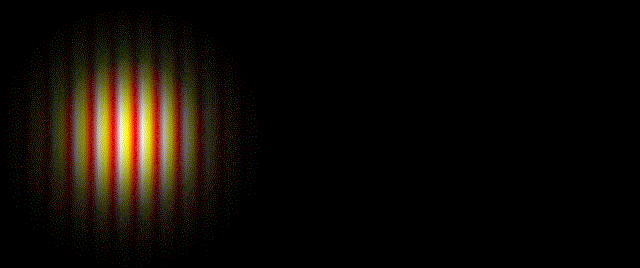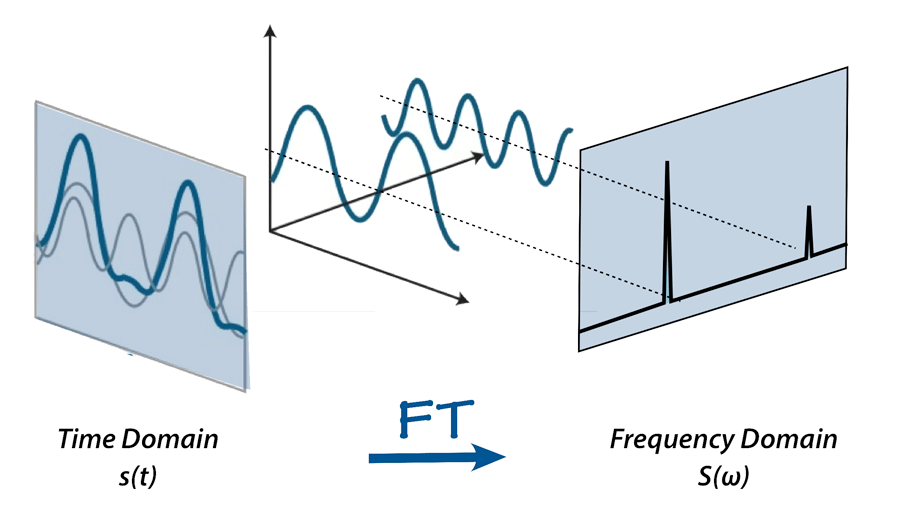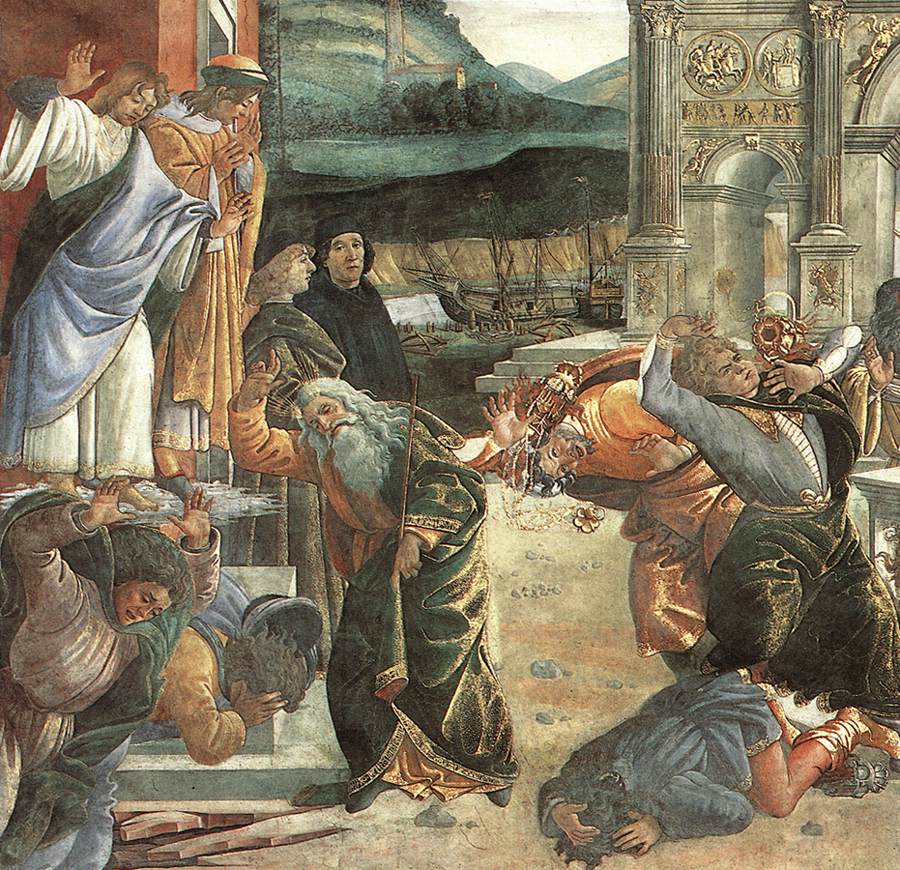The Lord spoke to Moses, saying: Speak to the children of Israel and you shall say to them that they shall make for themselves fringes [ẓiẓit] on the corners of their garments, throughout their generations, and they shall affix a thread of sky blue [wool] on the fringe of each corner. (Num. 15:37,38)
They [Koraḥ and his men] assembled against Moses and Aaron, and said to them, “You take too much upon yourselves, for the entire congregation are all holy, and the Lord is in their midst. So why do you raise yourselves above the Lord’s assembly” (Num. 16:3)
The Torah portion Shelach deals primarily with the fiasco of the spies sent by Moses to scout out the land of Canaan. The portion ends, however, seemingly out of turn, with the commandment to wear ẓiẓit or tzitzit (“fringes,” “tassels,” or “strings”) on a four-corner garment. The following Torah portion, Koraḥ, deals with another disaster, the rebellion of Koraḥ (or Korach). What is the connection between these two Torah portions? Why does the story of Koraḥ follow the commandment of ẓiẓit? The Jerusalem Talmud (as well as some ancient anonymous sources referred to as Pseudo-Philo sources, Liber Antiquitatum Biblicarum) already links the commandment of ẓiẓit with Koraḥ. To understand this, let us examine the meaning of ẓiẓit.
Ẓiẓit
The Torah instructs Jewish men to wear ẓiẓit on the corners of a four-corner garment. The performance of the precept requires two main components: the beged (the “garment”) with four corners, and ẓiẓit, the strings attached to the four corners of the garment. Another notable detail is teḵelet or tekhelet—the blue (or turquoise) string:
…and they shall affix a thread of sky blue [wool] on the fringe of each corner.”

The blue string is added to the white strings, which we will discuss later. For now, let us focus on the big picture—the garment (beged) with the fringes (ẓiẓit) at the corners.
The garment could be of any shape and color. There are very few requirements, only that it has four corners and must have a minimum size (to qualify as a garment, rather than, say, a scarf or a handkerchief). The ẓiẓit, on the other hand, have many detailed requirements related to the number of strings, the number of knots, the manner in which the knots are tied, and the color of the strings.
Today, Jewish men wear two types of garments with fringes: tallit gadol used during prayer, and tallit katan worn as an undergarment the whole day. The difference is only the size—tallit gadol is large, and tallit katan is small, although in Kabbalah they represent two different types of surrounding light, makif (far makif and near makif). Both are made of a rectangular piece of cloth with ẓiẓit-strings attached to its four corners.
The primary feature of this commandment—the juxtaposition of strings over a whole piece of cloth—is symbolic of the juxtaposition of prat (“part” or “detail”) and klal (“whole”). Klal, usually translated as “general,” (as opposed to particular), “whole,” (as opposed to a part), or a community (as opposed to the individual members of the community), represents a holistic view, the view of the whole forest, as opposed to individual trees. Prat, on the other hand, means “particular,” i.e., a detail or an aspect of a whole, a tree in the proverbial forest.
The dynamic of klal and prat is at the center of Torah Hermeneutics. Any concept could be analyzed as a whole, from a more general, holistic point of view, or it could be viewed as a sum-total of its parts, in which case the focus is on details and particulars. The Oral Torah provides thirteen rules for biblical exegesis. These rules were formulated by Rabbi Yishmael in the Baraita as the introduction to Sifra. Of the thirteen principles, eight principles (Nos. 4-11) involve the dynamics of klal and prat. One might say klal and prat is the central theme of Torah exegesis. The dialectic tension between klal and prat, between general and particular makes up a significant portion of the body of Oral Torah as expounded in Mishna and Talmud.
The commandment of wearing ẓiẓit is emblematic of klal and prat, because the beged (the garment itself) represents the klal, whereas the ẓiẓit (fringes) represent particulars. One without the other is deficient. A garment that has four corners but no ẓiẓit is forbidden to wear. Ẓiẓit-tassels by themselves are worthless if not attached to a garment. Wearing tassels alone (say attached to the belt) does not accomplish anything—it is not a mitzvah. Only by wearing them together, with ẓiẓit attached to the four corners of the garment, as prescribed by Halachah, the Jewish ritual law, one can fulfill this Biblical precept, a mitzvah.
Aside from the klal and prat dynamics, the other major theme of this commandment is the blue thread, teḵelet:
…and they shall affix a thread of sky blue [wool] on the fringe of each corner.”
This means that out of eight half-strings to be attached to each corner of a garment, at least one (but no more than half) should be blue. This color combination creates a tension between white and blue colors. It is reasonable to ask what is the connection between these two themes: klal and prat, on the one hand, and blue and white on the other.

The connection is rather obvious—both represent the tension between the sefirah of Chesed (love, kindness) and the sefirah of Gevurah (strength, strict judgment). As late Rabbi Aryeh Kaplan writes in The Inner Space, the dialectic tension between the opposites is represented in each of the three triads of the sefirotic tree: thesis-antithesis-synthesis. In the second sefirotic triad, ḥesed-gevurah-tiferet, ḥesed represents a thesis, whereas gevurah represents the antithesis. The wholesomeness of the klal (general, whole) symbolized by the beged (garment) represents ḥesed. On the other hand, the prat (particulars), which breaks the klal into its constituent parts and particulars symbolized by the strings, represents gevurah.
The same ḥesed-gevurah dynamic plays out in the colors of the ẓiẓit strings: white symbolized ḥesed, whereas blue symbolized gevurah (Zohar Vol. 3 p. 227a; Likutei Torah, Shelach). As the Psalmist says:
Sur merah v’aseh tov” – run away from evil and do good. (Psalms 37:27)
Sur merah (run away from evil) represents gevurah, whereas aseh tov (do good) represents ḥesed. As I wrote in my essay, “String Theory,” Jewish Sages tell us that the white strings symbolize the aseh tov (do good), which is the attribute of ḥesed, whereas the blue string, teḵelet, symbolizes the sur merah (run away from evil), which is the attribute of gevurah.
It seems that there is even a deeper connection between the dynamics of klal and prat, on the one hand, and white and blue, on the other. To explore this connection, however, we must take an excursion into quantum physics.
Wave-particle dualism
In physics, we also find a similar tension between klal and prat, between general and particular—it is the wave-particle dualism. It is not coincidental that, in the English language, the words “particle” and “particular” share the same root, as they both come from Latin particula meaning “little bit” or “part.”
In quantum physics, every object could be viewed as a wave or as a particle (depending on what properties we chose to observe). In our everyday life, we encounter particles and waves separately. Some objects can be idealized as point-like objects or particles. When we look at the surface of a lake or an ocean, we see waves, which are spread in space. These familiar concepts of particles and waves fail us when applied to the microworld of subatomic particles. Just as a garment without ẓiẓit or ẓiẓit alone without a garment are worthless, concepts of “wave” and “particle” by themselves are inadequate to describe the reality of the subatomic objects, which are neither particles nor waves, but possess properties of both. Only wave-particle duality, where the concepts of “wave” and “particle” are taken as particular manifestations of a greater whole that transcends either label, produces the correct description of sub-atomic particles. Einstein said it best:
We have two contradictory pictures of reality; separately neither of them fully explains the phenomena of light, but together they do.” (Albert Einstein, Leopold Infeld (1938). The Evolution of Physics)
As Louis de Broglie realized in 1924, all particles, not just quanta of light, possess wave properties, such as frequency and wavelength. I wrote about wave-particle duality in my earlier essay, Jacob Teaches Wave-Particle Duality and First Fruits and the Wave-Particle Duality of Nature, and will not further elaborate on it. Here, I would like to stress only the connection of the quantum-mechanical wave-particle dualism with the notion of klal and prat in general, and with the commandment of ẓiẓit in particular (no pun intended).
I associate waves with klal (“general” or whole) because they are spread out in space. Therefore, one cannot see a wave by focusing on a particular spot. To see waves, one needs to take a broad and expansive view of the wave as a whole (at least, one whole cycle of the wave from one crest to the next crest, or from one trough to the next trough).
On the other hand, particles are localized in space. One can zoom in on a particle to investigate its properties disregarding the global picture. That is why particles represent the prat aspect of the klal–prat dynamics.

Wave-particle duality inevitably leads to the Heisenberg Uncertainty Principle.
All periodic processes can be analyzed using the Fourier transform. The Fourier transform decomposes a function of time into its constituent frequencies. This is a mathematical technique well-familiar not only to physicists and mathematicians but to many engineers as well, as it is widely used in signal processing and acoustics. The French mathematician Fourier showed that all complex periodic processes, such as soundwaves, for example, may be represented as a sum of simple sinusoid functions of different frequencies. Furthermore, Fourier developed a technique to simplify the analysis by transforming it from the time domain to the frequency domain. Without delving into the mathematics behind it, suffice it is to say that the wave-particle duality and the Heisenberg uncertainty principle follow naturally from Fourier formalism.

Going back to our muttons, one might say that the beged (klal – general) vs. strings (prat – particular) dynamic., which parallels the wave-particle duality, is conceptually parallel to the Fourier transform formalism.
A careful reader will notice that the Fourier transform applies only to periodic functions describing periodic processes. Where do we see any hint of periodicity in the mitzvah of ẓiẓit? The strings, of course!
As I wrote in my essay, “String Theory,” the dynamics of sur merah (run away from evil) vs. aseh tov (do good) creates the “vibrations of the strings.” Indeed, as we discussed before, in his vision of Maaseh Merkavah, “the Work of the Chariot,” Ezekiel sees angels running and returning (Heb. ratzo vashov). The concept of aseh tov (do good) is a manifestation of ratzo (running towards doing good), whereas sur merah (running away from evil) is a manifestation of shov (returning). As I wrote in my essay “Paradox of the Red Heifer,” ratzo vashov sets off the basic rhythm of creation.
So, it is the dynamics of white strings vs. blue strings (teḵelet) that set off the rhythm that is responsible for the klal-prat dynamics of beged (garment) vs. ẓiẓit (strings). It took some physics and mathematics to uncover this hidden connection.
Koraḥ
The story of Koraḥ is the continuation of the story told in the commandment of ẓiẓit—the story of the tension between klal (general) and prat (particular), between beged (garment) and ẓiẓit (strings).
What is Koraḥ’s complaint to Moses?
the entire congregation are all holy… So why do you raise yourselves above the Lord’s assembly?” (Num. 16:3)
What Koraḥ says is that everybody (klal-congregation) is holy—so why do we need Moses and Aaron as leaders (prat) to be above the congregation? Koraḥ does not see klal-prat dynamics, nor does he understand the need for particulars (prat). He only sees the generalities (klal).
The Midrash elaborates further that Koraḥ asked Moses, “If the room is full of Torah scrolls, does the room require a mezuzah?” Moses answered in the affirmative and Koraḥ, and his company laughed. Koraḥ failed to see the need for a particular section of the Torah written on a mezuzah scroll (prat) when the room is full of Torah scrolls (klal).
Jerusalem Talmud quotes a Midrash, according to which Koraḥ dyed a garment blue and brought it to Moses. He asked, If the whole garment is dyed blue, does it require teḵelet, the blue string? Moses answered in the affirmative. Hearing this, Koraḥ claimed that Torah was not given by G‑d, Moses was not a prophet, and Aaron was not the High Priest (Jerusalem Talmud, tr. Sanhedrin 10:1). Once again, Koraḥ failed to see the import of a particular blue string in view of the whole blue garment. The reference to ẓiẓit and teḵelet in the debate between Koraḥ and Moses is not coincidental—this is a hint at the previous Torah portion and the commandment of ẓiẓit, which is symbolic of the dynamics of klal and prat that is lost on Koraḥ.
Moses, who, unlike Koraḥ, understands klal-prat dynamics, argues with G‑d, raising the question of collective responsibility: if one person (prat) sins, would G‑d punish the entire community (klal)? Like Abraham in Genesis 18:23, Moses urges G‑d to limit the punishment only to the guilty and spare the innocent—this is the prat approach, as the antithesis to the klal approach advocated by Koraḥ. Similarly, G‑d tells Moses and Aaron:
Separate yourselves from among this congregation.” (Num. 16:21)
referring to Koraḥ and his band, and telling Moses and Aaron to separate (prat) from this evil congregation (klal).
Koraḥ and his cohort, on the other hand, were punished (measure for measure) in accord with the principle of klal (which, in Koraḥ’s opinion, negated prat) — they were punished with their wives and small children.
And the earth opened her mouth and swallowed them up, and their households, and all the men that appertained unto Koraḥ , and all their goods. (Num. 16:32)
Moreover, the verse concludes, “they perished from among the assembly.” (Ibid, 33) again emphasizing the punishment in the mode of klal, as a measure for measure.

Let us recall that the wave-particle duality exists in the state of superposition. Once the wave function is collapsed, either the wave OR the corpuscular properties are manifest. For example, in the double-slit experiment, an electron is in a superposition of states of being a wave and a particle until we measure it—if we monitor, which slit it goes through, it behaves as a particle; but if we focus our attention on the second screen (behind the screen with two slits), the electron behaves as a wave causing the interference pattern. By denying klal-prat dynamics, Koraḥ denied wave-particle dualism and, therefore, the notion of superposition. Koraḥ was punished by the earth opening its mouth and swallowing him and his band. The Ethics of the Fathers (Pirke Avot) states that this was one of ten miracles created on the twilight of the first Friday of creation. As I have written before, twilight is a time in the state of superposition—not day, not night, not both, not neither, but the fifth unique state. Thus, it was fitting (measure-for-measure) to apply this punishment to Koraḥ.
The klal-prat dynamic manifests itself in spiritual realms, as we see in the Biblical narrative of Koraḥ’s rebellion and the commandment of ẓiẓit, as well as in our physical reality, as we see in wave-particle duality. This structural parallel is not only amusing but it helped uncover the hidden aspects of the mitzvah of ẓiẓit, as we discussed above–a nice example of the cross-pollination of ideas in a multidisciplinary approach advocated on this blog.


Dear Alexander,
I enjoy reading about how quantum mechanics and the Torah are compatible; however, I have a problem with the idea that large scale quantum computers (which can factor integers) are possible and cannot see how they can be compatible with the Torah, since they seem to me to be magical. I wrote a paper “Why do we live in a quantum world?” here which describes how I see QM – https://www.ingentaconnect.com/content/pe/pe/2017/00000030/00000001/art00008 (you can also see a preprint on vixra.org)
The rumor is that Google tested a 53 qubit quantum computer and it passed their statistical test. How do you view large scale quantum computers in terms of Torah?
Shana tova!
Google’s paper came out this week and indeed they claim that the tests done with their 53 qubit quantum computer passed. However, the verse in Kohelet 1:9
מַה-שֶּׁהָיָה, הוּא שֶׁיִּהְיֶה, וּמַה-שֶּׁנַּעֲשָׂה, הוּא שֶׁיֵּעָשֶׂה; וְאֵין כָּל-חָדָשׁ, תַּחַת הַשָּׁמֶשׁ.
“That which hath been is that which shall be, and that which hath been done is that which shall be done; and there is nothing new under the sun.”
indicates to me that larger large-scale quantum computers will fail. I never realized it before, but the common English translation of this verse (above) is not the most accurate translation. It should really read “there is nothing *entirely* new under the sun”.
A 53 qubit quantum computer is new, but not entirely new (since it can be simulated with a digital computer), so it can be created. A quantum computer that can efficiently factor large integers would be entirely new (since a digital computer cannot do it efficiently), so it cannot possibly be created.
A native Hebrew speaker just told me that the “nothing new under the sun” is indeed correct and that my addition “entirely” is incorrect. But still if one interprets “new” to mean entirely new, my interpretation still applies.